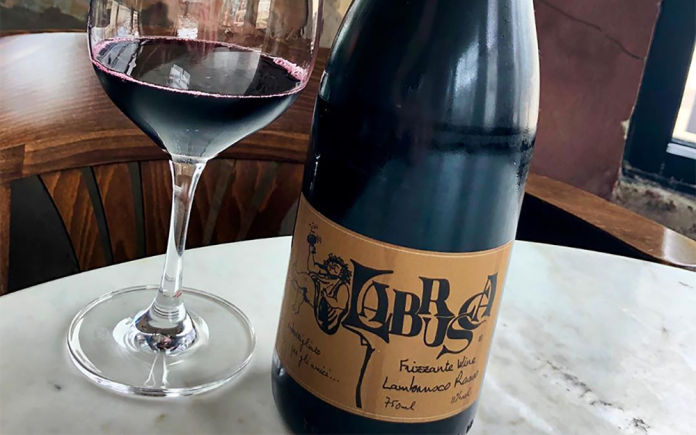
By Rick Riozza
Hopefully this alliterative title has piqued your interest and you’ll give this article a touch more time on your busy schedule.
We know the “lambrusco” of days past pretty much did the wine in, here in the states, as far as “quality” went. Those of a certain age will wryly remember the TV add, “Riunite on ice, it’s nice” or “Chill a Cella/Chill with Cella”. But the slightly effervescent sweetish red was good for the young adult party scene. (Is it still?)
If you weren’t there, the internet tells us, “For the better part of the 20th century, it was made in a sugary, sparkling, low-alcohol style that earned the mocking metaphor “the Coca-Cola of wines.” To raised-on-sweets Americans, these wines were enormously popular; 40 years ago, five of the six bestselling imported wines were Lambruscos.”
And it was easy to forget about—unless you had had the “real stuff” from the Italian region of Emilia-Romagna where one of the world’s food capitals, Bologna, is situated.
As you readers would suspect, we’re going to recommend a couple really tasty Lambrusco wine—but, of course, not after we do that didactic thing and bring to light some truth about Lambrusco wine:
Wine.com states, “Like Prosecco, Lambrusco is both a grape and a type of regional wine from northern Italy. The grape’s history dates to the Etruscans, and Cato the Elder gushed about it in his 160 B.C. manual “De Agri Cultura” (“On Agriculture”). Its sub-varieties are grown all over Italy and as far afield as Australia, but wines labeled Lambrusco come from several sub-regions in Emilia-Romagna and one in Lombardy.
And to add to our persuasion, realize that One of those sub-regions is Modena; and in classic wine lore. “that which grows together, goes together. In other words, whatever the local land provides—so does the wine. Here, the area provides the Parmigiano-Reggiano, and, Prosciutto that the entire world loves—so what are you thinking about the local Lambrusco! It’s been said by many Italians, American Italians, and folks of any heritage, that “Prosciutto, Parmigiamo-Reggiano and Lambrusco, could be consumed all day long with no complaints! Buon Appetito!
Okay so you’ve figured out that being a wine enthusiast means you’re willing to give the “new wave” Lambrusco a new try. Com’è progressista! (How progressive you are!)
Wine Lovers Kitchen has recently concisely written, “Lambrusco is the ‘wild child’ of sparkling wines. This one is true to form—startlingly dark cherry in the glass. It is dry and zesty with tart cherry on the palate. Lambrusco is not a sparkling for sipping or toasting;it is designed to go with food. Tame it with hard, old cheeses and charcuterie.” There you go—that’s a quick apt description!
Those notable restaurants in-the-know, say Lambrusco dances deftly with so many dishes. “They’re such good food wines. “They have everything: good fruit, [mouthwatering acidity] and herbal qualities that accentuate the food.”
And now: a couple of current recommendations: Lini non-vintage 910 Labrusca Lambrusco Rosso ($15) The winemaker’s notes state: “Lini’s wines are renowned for their signature freshness and classic dry character. Thanks to Fabio Lini’s artisanal approach to sparkling wine production, their bright red fruit and berry flavors are balanced by juicy minerality. Their clean but lingering finish makes them an ideal pairing for a wide variety of cuisines. A blend of 85% Salanino and 15% Ancellota.
“Lini Lambrusco is the quintessential pairing for Emilian gastronomy: classic dishes of Emilia like lasagne and tagliatelle alla bolognese, tortellini in brodo, and the region’s famous cured meats. But its remarkable versatility also makes it a wonderful match for a wide variety of cuisines, including Asian, Mexican, and classic American. Many top sommeliers reach for Lini wines to pair with oysters. And many claim it’s the ultimate BBQ wine.”
(And may I add that my mom, with her Italian-Sicilian heritage, loves Lambrusco with pork/beef/cheese tamales!—me, I love it with pizza and hot & spicy Sichuan dishes.)
The Lini Family has been making Lambrusco since 1910. “Labrusca” is the grape’s ancient name, from the Latin labrum meaning “edge”. Low in alcohol, with bright acidity and loads of fruit in the mouth, this gently sparkling red wine is the ideal complement to the rich foods of the Emilia region.
Lini’s wines are renowned for their signature freshness and classic dry character. Thanks to Fabio Lini’s artisanal approach to sparkling wine production, their bright red fruit and berry flavors are balanced by juicy minerality. Their clean but lingering finish makes them an ideal pairing for a wide variety of cuisines.
The Wine Enthusiast chimes in with: “The Lini Lambrusco is tangy and mostly dry, with snappy plum-skin tannins that frame dense dark-berry flavors, Labrusca is a superb value built for barbecue.”
Medici Ermite NV Metodo Ancestrale—Lambrusco di Modena ($27) Here there is wild berry, dried rose, violet and an unusual but intriguing whiff of garrigue lift out of the glass. On the savory side, find fizzy and vibrant acidity showing succulent red cherry, white peach, strawberry, lemon zest and bread dough. It’s fun and easy drinking but also loaded with personality.
We love this Ermite Lambrusco, not because the winemaker invited us to stay at his vineyard property when we were in Italy, but because it’s a delicious wine! Saluti!!










































